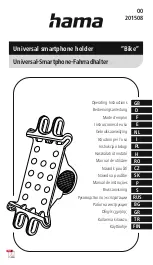
2
Safe towing practices
continued from preceding page
as you slowly turn sharply to see whether you have this
potential problem. If you do, note how far you can safely
turn the motorhome’s steering wheel, and be sure not
to turn it further when towing. Damage that results from
turning too sharply is not covered by warranty.
• Never use the tow bar to tow more than one vehicle.
In some states it is legal to have one vehicle towing more
than just one vehicle (for example, a truck which is towing
a trailer which is towing a boat). However, when using a
tow bar, never tow more than one vehicle, or non-warranty
damage or injury may result.
• The hitch ball must be two inches in diameter.
If the
hitch ball diameter is smaller than two inches, the coupler
may disengage during towing.
Also, the diameter of the threaded hitch ball shank
(Figure 2) must match the diameter of the hole in the
ball mount hitch. If the threaded shank is too small, tow-
ing vibrations could cause the hitch ball to unthread and
separate from the ball mount hitch.
• Keep the tow bar clean and well-lubricated.
As is
the case with most precision equipment, frequent cleaning
and care results in better performance and longevity.
Refer to the section titled “Care and cleaning” for further
information.
Failure to follow these instructions may cause prop-
erty damage, personal injury or even death.
INSTALLER'S SAFETY CHECKLIST
The following safety checklist is provided to the installer
with the instructions for installing the StowMaster All Ter-
rain
tow bar. It is repeated here for your information.
As a precaution, verify that all safety requirements have
been followed before towing the vehicle.
• The installer must be sure that the vehicle is suit-
able or adaptable for towing.
Some vehicles must be
equipped with a transmission lube pump, an axle discon-
nect, driveline disconnect or free-wheeling hubs before
they can be towed. Failure to properly equip the vehicle
will cause severe damage to the transmission.
Check the manufacturer’s instructions for the proper
procedure(s) to prepare the vehicle for towing.
• Read the instructions thoroughly before installing
the ‘quick-disconnect’ (‘QD’) system and its compo-
nents.
The tow bar will be attached to the QD system.
If the QD system is not properly aligned, centered and
positioned on the towed vehicle, the tow bar will not be
centered on the towed vehicle, which may cause exces-
sive tire wear and other consequential, non-warranty dam-
age.
• Stress to the owner that the tow bar must be ap-
proximately level with the ball hitch on the motorhome.
Towing with the tow bar at an upward or downward slope
puts undue strain on the tow bar mounting bracket and the
ball mount. Driving over sharp inclines or declines could
force the coupler off the hitch ball.
• Show the owner how to properly operate the tow
bar.
Familiarize yourself with the features of the tow bar.
Demonstrate them to the owner, and ask the owner to
connect and disconnect the tow bar and other components
of the towing system, until the owner is comfortable with
its operation.
• Advise the owner to always use safety cables when
towing.
The safety cables must connect the towed vehicle
to the towing vehicle, frame to frame.
The weight capacity of the safety cables must meet
or exceed the towed weight, or the safety cables will
fail.
•
The StowMaster All Terrain
tow bar is rated at a maxi-
Figure 3
mum of 6,000 pounds carrying capacity; therefore
the
weight of the towed vehicle and all its contents can-
not exceed 6,000 pounds.
In addition, the hitch ball, the
receiver hitch, the safety cables and all supplementary
towing equipment must be rated at no less than the weight
of the towed vehicle and all its contents.
• Caution the owner to use a hitch ball with a two-
inch diameter.
If the hitch ball diameter is smaller than
two inches, the coupler may disengage during towing.
In addition, the diameter of the threaded hitch ball
shank must match the diameter of the hole size in the ball
mount hitch. If the threaded hitch ball shank is too small,
towing vibrations could cause the hitch ball to unthread
and separate from the ball mount hitch.
• The tow bar must be attached to a bracket which is
bolted to the towed vehicle’s frame or unibody.
In order
to be towed, virtually all vehicles require a tow bar mount-
ing bracket that is connected to the frame, unibody or
chassis and extends beyond the bumper.
• The tow bar must be mounted upright, with the cou-
pler facing out.
See Figure 3. Never mount the tow bar
with the coupler facing any other way — the tow bar arms
and other components will be severely damaged during
towing.
• Caution the owner to secure the tow bar with linch
pins (or optional padlocks) before towing.
Unless the
tow bar is secured to both vehicles with all appropriate
pins (or padlocks), the towed vehicle will detach.
• The installer must NOT use the tow bar as a ground
for welding.
Connecting a ground to the ‘A-frame’ of the
tow bar will cause current to flow through the locking
continued on next page
Summary of Contents for StowMaster ALL TERRAIN
Page 1: ......
































